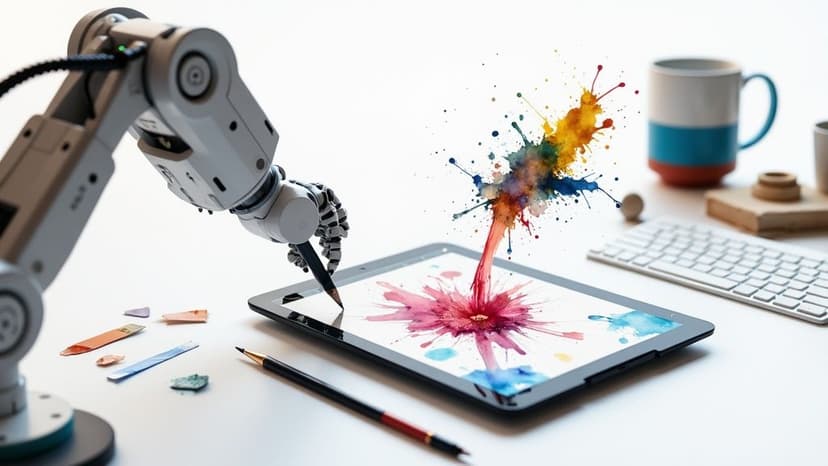
12 Best AI Tools for Graphic Design in 2025 (UK Guide)
Explore our guide to the 12 best AI tools for graphic design. Find top picks for image creation, workflow automation, and brand-safe visuals in 2025.
Discover 8 innovative identity cards designs that can elevate your brand. Get inspired and create memorable identity cards designs for 2025!
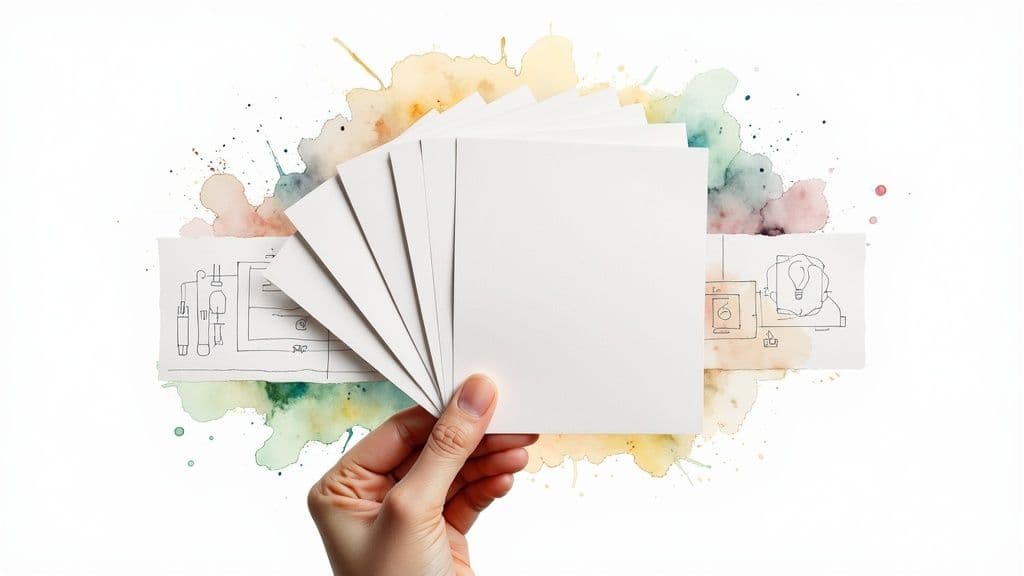
Instastock Team
October 10, 2025 • 14 min read
In a world of digital profiles, the humble identity card remains a powerful, tangible symbol of belonging and security. But a truly great ID is more than just a name and photo; it's a statement of brand, a tool for seamless access, and a reflection of organisational culture. Too often, they are treated as a purely functional afterthought, missing a key opportunity to make a lasting impression.
This guide moves beyond the basics. We will explore 8 standout examples of identity cards designs, breaking down precisely what makes each one effective and memorable. From the calculated simplicity of minimalist corporate IDs to the advanced security features of government-issued smart cards, you will discover actionable strategies and creative insights to inspire your own projects.
We will analyse the ‘why’ behind each design choice, focusing on the strategic thinking that transforms a simple piece of plastic into a powerful asset. By the end, you'll have the tactical knowledge needed to create cards that are not only functional but also communicate brand identity and build a sense of community. Let’s dive into the designs that get it right.
Minimalist design isn't just about empty space; it’s a strategic choice that communicates professionalism and efficiency. This approach to identity card design strips away distracting elements, focusing solely on essential information presented in a clean, uncluttered layout. It relies on a limited colour palette, ample white space, and crisp typography to create a powerful first impression of an organised and modern brand.
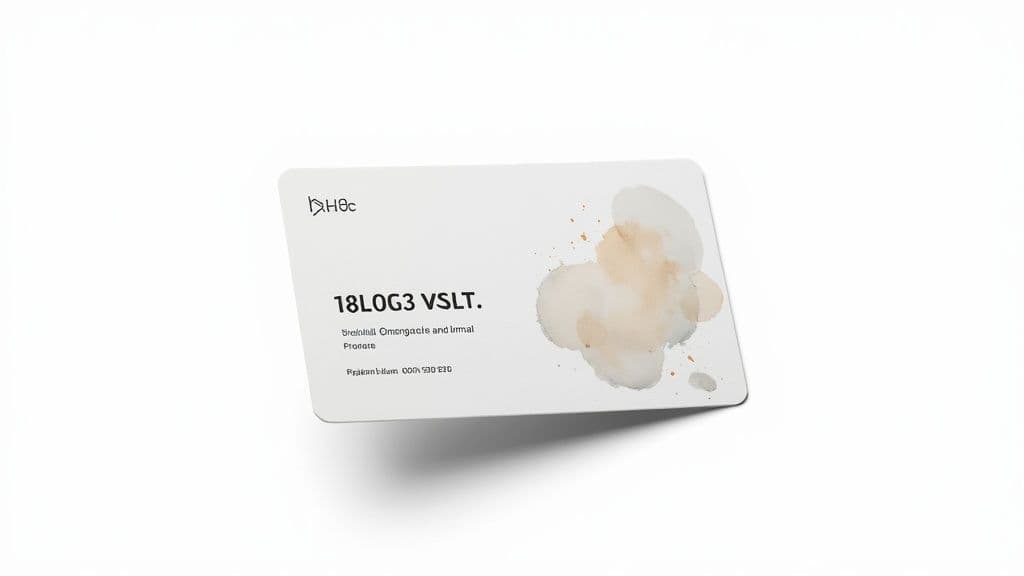
This philosophy is championed by tech giants like Apple and Google, whose employee badges are instantly recognisable for their simplicity. By removing visual noise, these designs ensure that key details like the employee's name, photo, and company logo are immediately scannable, enhancing both security and brand identity.
Minimalism in ID cards is effective because it projects confidence and clarity. An uncluttered card implies that the brand is so well-established it doesn’t need flashy graphics to make a statement. This approach is particularly well-suited for corporate environments, tech companies, and financial institutions where professionalism, security, and efficiency are paramount.
Key Takeaway: A minimalist design enhances readability and reinforces a brand image of sophistication and focus. The less-is-more approach makes vital information stand out, which is critical for security personnel who need to verify identities quickly.
Ready to adopt a minimalist approach for your identity cards? Here are some actionable tips:
Government-issued smart ID cards represent a major leap in personal identification, blending traditional identity verification with advanced digital security. These cards feature an embedded microchip that securely stores personal and biometric data, acting as a digital key for citizens. This technology moves beyond a simple photo and name, enabling secure access to e-government services, digital signatures, and streamlined border control, all within a single, highly protected document.
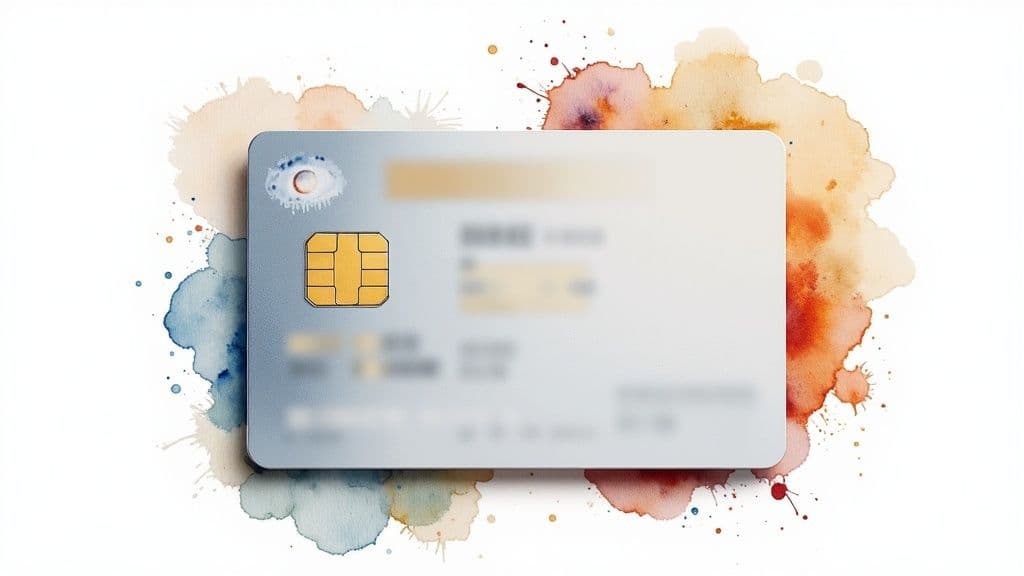
This evolution in identity cards designs is exemplified by Estonia’s pioneering e-ID card, which boasts over 98% citizen adoption and is central to its digital society. Similarly, Germany's Personalausweis and the UAE's Emirates ID integrate sophisticated eID functions for secure online authentication, showcasing how national IDs are becoming cornerstones of modern digital infrastructure.
The effectiveness of smart ID cards lies in their multi-layered security and unparalleled utility. The combination of physical security features with cryptographic protection on the microchip makes them incredibly difficult to forge. This robust security builds public trust and provides a reliable foundation for a wide range of digital services, from online tax filing to accessing health records, ultimately making civic life more efficient and secure.
Key Takeaway: Smart ID cards transform a basic identification document into a multi-purpose tool for digital citizenship. Their design focus is on integrating complex technology into a functional, secure, and user-friendly format that citizens can rely on for both physical and online interactions.
While creating a national ID is a governmental task, the principles of secure and functional design are universal. Here’s how to apply them:
In educational settings, quick and accurate identification is paramount. Photo-centric student ID cards address this need by making the individual's photograph the most prominent element, often taking up 30-50% of the card's surface. This design philosophy prioritises immediate visual verification, which is crucial for maintaining security and fostering a sense of community on campus.
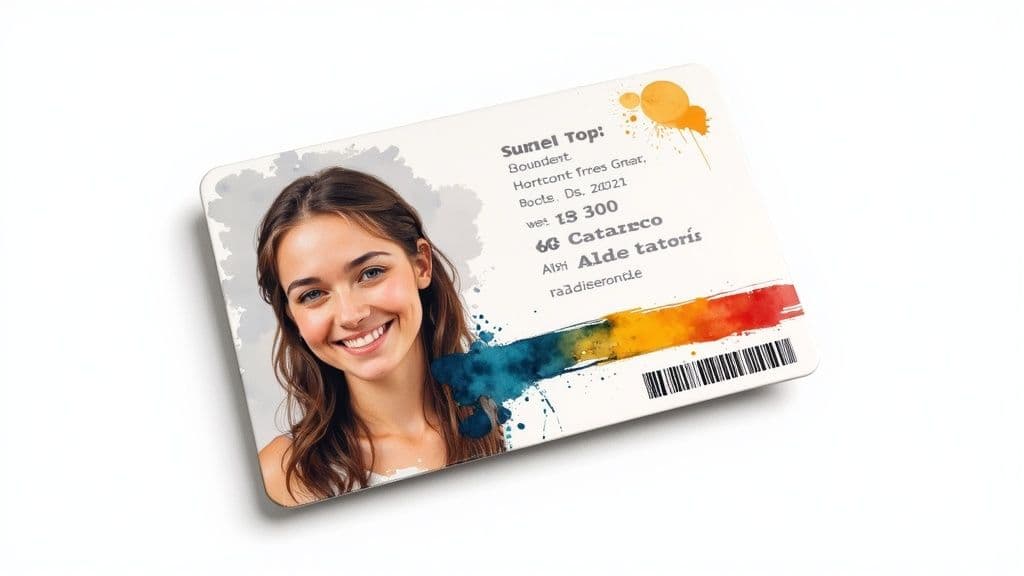
This approach is a staple at major institutions like the University of Michigan and Harvard University. Their IDs use a large photo alongside clear branding and essential student details. The design makes it simple for staff, security, and even other students to confirm identities at a glance, streamlining access to libraries, meal plans, and secure buildings.
A photo-centric design is effective because it leaves no room for ambiguity. By making the face the focal point, the card’s primary function, identification, is served instantly. This is vital in busy school environments, from K-12 campuses using colour-coded grade levels to sprawling university settings where thousands of students interact daily. It enhances security protocols without being intrusive.
Key Takeaway: Placing a large, clear photo at the forefront of identity cards designs dramatically improves on-the-spot verification, boosting campus safety and operational efficiency. It's a simple, powerful tool for community management.
Looking to improve your institution's ID cards? Here’s how to create effective photo-centric designs:
In fast-paced medical environments, quick and accurate identification is not just a convenience; it's a critical safety feature. Colour-coded identity cards designs provide an immediate visual cue to a staff member's role, department, and clearance level. This system uses distinct colours, patterns, or borders to differentiate between doctors, nurses, administrators, and visitors, enhancing both security and operational efficiency.
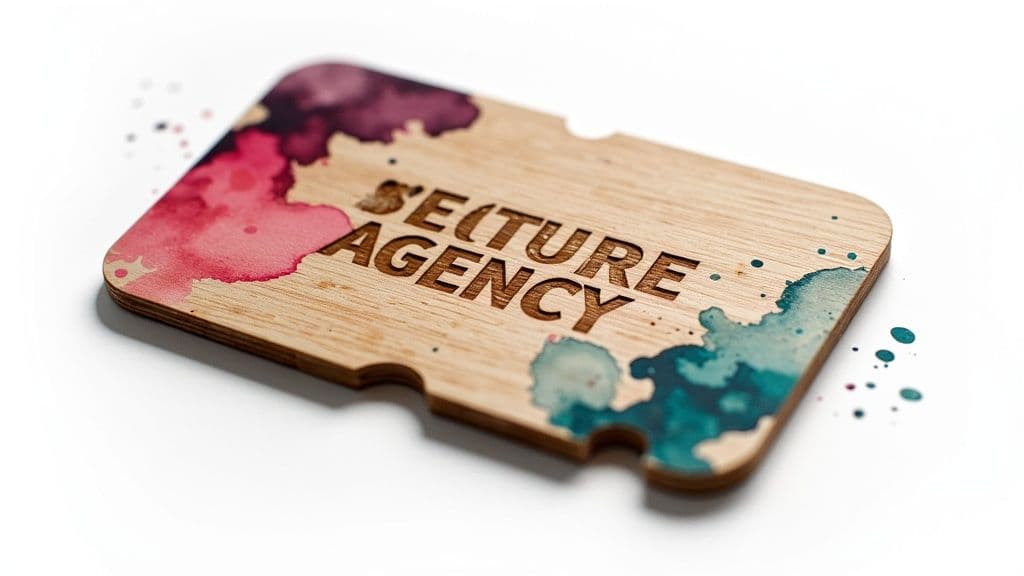
This functional approach is widely adopted by major healthcare providers like the NHS in the UK and Johns Hopkins Hospital. During a medical emergency, this visual system allows team leaders to instantly identify necessary personnel, such as a respiratory therapist or a senior surgeon, saving precious seconds. It also helps patients and their families easily recognise who is providing their care, fostering trust and clarity.
Colour-coding is effective in healthcare because it streamlines communication in a high-stakes setting. The brain processes colour faster than text, making it an invaluable tool for rapid identification. This system improves security by making it easy to spot unauthorised individuals in restricted areas and enhances patient safety by ensuring the right person is performing the right task. The design balances professionalism with life-saving functionality.
Key Takeaway: A colour-coded system transforms an ID card from a simple identifier into a vital tool for safety and operational coordination. This visual hierarchy is crucial for rapid role identification during emergencies and for maintaining secure access control in sensitive areas.
Looking to improve safety and efficiency with your healthcare identity cards designs? Here are some key steps:
Membership cards are more than just a way to prove you belong; they are a powerful tool for building customer loyalty and creating a sense of community. This approach transforms a simple identity card into an interactive asset by integrating it with a loyalty programme. These designs combine essential identification features with elements that track rewards, points, or tier status, making the card a key part of the customer experience.
This strategy was pioneered by companies like American Express with its premium tiered memberships and popularised by brands like Starbucks, which seamlessly integrated its physical card with a revolutionary mobile app. These identity cards designs don't just grant access; they reward engagement, encouraging repeat business and turning casual customers into loyal brand advocates.
Integrating loyalty features into an ID card makes the customer feel valued and part of an exclusive group. It provides a tangible reminder of the benefits they receive, from discounts at Barnes & Noble to access at a 24 Hour Fitness gym. This dual functionality keeps the brand top-of-mind and provides valuable data on customer behaviour, allowing for more personalised marketing and offers.
Key Takeaway: Combining identification with loyalty programmes transforms the card from a simple utility into a desirable object. It reinforces the value of membership every time the customer uses it, fostering a deeper, more engaging brand relationship.
Want to turn your membership cards into loyalty-building powerhouses? Here are some practical tips:
Moving beyond aesthetics, some identity card designs prioritise one thing above all else: impenetrable security. High-security access control cards are advanced credentials engineered for environments where a breach is not an option. These designs integrate multiple layers of technology, including smart chips, RFID/NFC, and holographic overlays, to create a robust authentication tool.
This level of security is standard for organisations like the U.S. Department of Defense with its Common Access Card (CAC) and research facilities such as CERN. The card is often just one part of a multi-factor authentication process, working with biometric scanners for fingerprint or iris verification. Here, the design's success is measured by its ability to prevent unauthorised access, not just its visual appeal.
This approach is the gold standard for protecting critical assets and information. The combination of something you have (the card) and something you are (a biometric marker) creates a formidable barrier against intrusion. For government facilities, data centres, and research labs, this design philosophy ensures that only verified personnel can access sensitive areas, providing accountability and peace of mind.
Key Takeaway: Integrating multiple security technologies into identity card designs creates a layered defence system. This makes credentials extremely difficult to clone or misuse, which is essential for high-stakes environments.
Looking to bolster security with advanced identity cards? Here are some essential tips:
For creative agencies and startups, an identity card is more than just a tool for access; it's a pocket-sized manifesto of their brand ethos. This approach pushes beyond traditional plastic, using unique materials like wood, metal, acrylic, or recycled composites to craft ID cards that are immediate conversation starters. These designs are bold, tactile, and serve as a physical embodiment of a company’s innovative and creative culture.
This trend is championed by companies that live and breathe design. Think of Patagonia’s use of recycled materials to underscore their environmental commitment, or Pentagram's famous rotating employee cards, each designed by a different partner. These unconventional identity cards designs don't just grant access; they tell a story and make employees feel like part of something special and forward-thinking.
Using non-traditional materials transforms a functional item into a memorable brand experience. It signals that the company values creativity, craftsmanship, and sustainability, right down to the smallest detail. This approach is perfect for design studios, tech startups, and any brand looking to make a strong cultural statement and stand out in a crowded market. It also reflects a commitment to quality and innovation that resonates with both employees and clients.
Key Takeaway: Unique materials turn a standard ID card into a powerful branding tool and a symbol of company culture. It shows a meticulous attention to detail and a willingness to invest in a creative and engaging employee experience.
Ready to create an ID card that truly represents your brand’s creative spirit? Here are a few ideas:
Not all identification needs to last forever. Temporary badges for visitors, contractors, and event attendees are specialised identity cards designed for short-term use, prioritising immediate recognition and controlled access. These designs focus on high visibility and clear expiration indicators to ensure that temporary personnel are easily identifiable and cannot overstay their welcome, a critical component of modern security protocols.
This approach is mastered by companies like Zebra Technologies and Envoy, who provide on-demand printing and visitor management systems. Many of these badges even incorporate self-expiring technology, where a "VOID" message or colour change appears after a set time. This simple yet effective feature prevents badge misuse and eliminates the security risk of unreturned cards.
The strength of temporary identity cards designs lies in their clarity and transient nature. By using bold colours, prominent "VISITOR" or "CONTRACTOR" text, and often a different orientation (e.g., vertical vs. horizontal for staff), they allow your permanent employees to instantly recognise who belongs and who is a guest. This visual distinction is a simple but powerful tool for maintaining a secure environment in busy places like corporate offices, hospitals, and construction sites.
Key Takeaway: Temporary badges provide a flexible and highly visible security solution. Their design focuses on clear role identification and often includes self-expiring features, making it easy to manage access for non-permanent personnel without complex deactivation procedures.
Need to manage temporary access effectively? Here’s how to design badges that enhance security:
| ID Card Type | Implementation Complexity 🔄 | Resource Requirements ⚡ | Expected Outcomes 📊 | Ideal Use Cases 💡 | Key Advantages ⭐ |
|---|---|---|---|---|---|
| Minimalist Corporate ID Cards | Low - simple design focused on clarity and consistency | Low - limited colors, basic printing techniques | Professional, easy-to-read IDs | Corporate environments needing scalable IDs | Timeless, cost-effective, scalable, professional |
| Government-Issued Smart ID Cards | High - requires embedded chips and encryption | High - specialized chips, secure printing, reader infrastructure | Secure digital identity, fraud reduction | National ID, border control, e-government services | Enhanced security, multi-layer authentication |
| Photo-Centric Student ID Cards | Medium - emphasis on quality photos and multi-function features | Medium - photo equipment, barcode/RFID tech | Fast visual ID, multi-use campus card | Schools, universities needing campus security | Immediate recognition, multi-functional |
| Healthcare Professional Credentials with Color-Coded Roles | Medium - color coding system plus security printing | Medium - color printing, badge production | Rapid role ID, enhanced security | Hospitals, large medical facilities | Instant role identification, improves coordination |
| Membership Cards with Integrated Loyalty Programs | Medium - combines ID and loyalty tracking technologies | Medium - printing, barcode/QR/NFC integration | Increased customer loyalty, marketing data | Retail, clubs, fitness centers | Encourages repeat business, personalized offers |
| High-Security Access Control Cards with Biometric Integration | Very High - multi-factor authentication system | Very High - advanced biometric systems, secure tech | Maximum security, detailed audit trails | Data centers, government, R&D labs | Extremely secure, granular access control |
| Creative Agency and Startup ID Cards with Unique Materials | Medium to High - innovative materials and custom designs | Medium to High - specialized materials and printing | Strong brand identity, memorable | Creative agencies, startups | Unique, brand-expressive, recruitment tool |
| Temporary Event and Contractor Badges | Low to Medium - on-demand printing with expiration tech | Low - thermal/color changing ink printers, minimal data | Quick issuance, visitor distinction | Events, contractors, temporary visitors | Fast production, distinguishes temporary status |
We've explored a fantastic range of identity cards designs, from the sleek minimalism of corporate IDs to the high-tech functionality of biometric access cards. The journey through these examples reveals a powerful, unifying truth: a great ID card is never just a piece of plastic. It's a strategic tool, a daily brand touchpoint, and a cornerstone of security and community.
The most successful designs all begin with a crystal-clear purpose. Before you even think about fonts or finishes, you must define your primary objective. Are you aiming to project a creative, unconventional brand image like the startups we saw? Or is your non-negotiable goal the impenetrable security demonstrated by government and high-tech examples? Answering this foundational question is the first step towards creating an ID that truly performs.
So, how do you translate these big ideas into a tangible design? The key is to borrow and blend principles strategically. You don't have to choose between brilliant branding and robust security; the best identity cards designs harmonise these elements.
Consider these core takeaways from our examples:
Ultimately, your ID card is a silent ambassador for your organisation. It’s held, used, and seen every single day, reinforcing your values and streamlining interactions. By thoughtfully combining strategic purpose with deliberate design choices, you can create a card that's not only impressive to look at but also a powerful asset that enhances efficiency, security, and a sense of belonging for everyone who carries it.
Ready to elevate your identity cards designs with one-of-a-kind visuals? With Instastock, you can instantly generate unique, AI-powered images and design elements that perfectly capture your brand’s spirit. Create everything from professional headshot backgrounds to custom abstract patterns in seconds, ensuring your cards are as distinctive as your organisation. Visit Instastock to start creating today!

Explore our guide to the 12 best AI tools for graphic design. Find top picks for image creation, workflow automation, and brand-safe visuals in 2025.
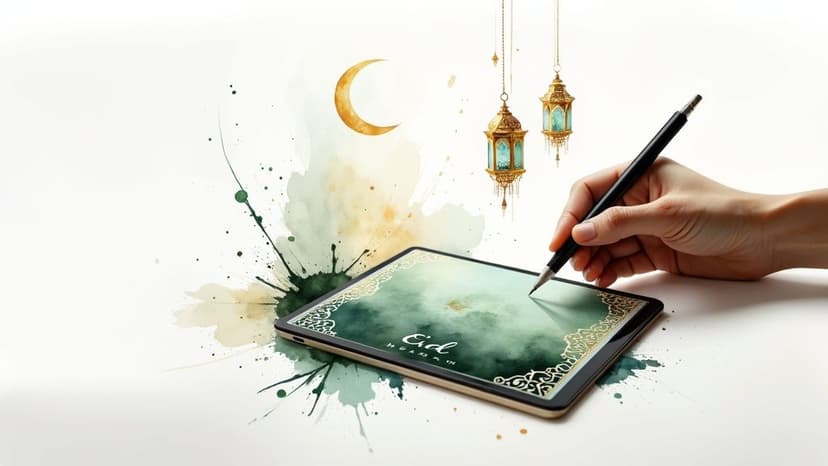
Learn how to design a stunning Eid Mubarak banner with AI. Our guide covers prompts, cultural tips, and how-to steps for a beautiful celebration.

A friendly guide to creating beautiful Christmas trees vector graphics. Learn AI prompts, customization tips, and how to use your festive designs.